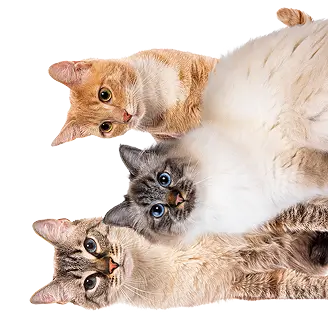Turkish Van


Turkish Van is a unique cat in many ways. Their unique and pristine white coat, is only marked with colours on the head and tail, and varies in length in winter and in summer. Impervious and dense, it also allows them to withstand the harsh weather and harsh climates of the mountainous regions of Turkey, from where they originated. Despite their elegance, this cat is more of an adventurer of gardens than of living rooms.
|
Life expectancy |
The Turkish Van has a life expectancy of between 14 and 19 years |
|
Temperament |
|
|
Adult size |
Female
Between 10 and 12 in
Male
Between 10 and 12 in
|
|
Adult weight |
Female
Between 11 and 13 lb
Male
Between 11 and 20 lb
|
|
Coat colour
There are two types of Turkish Van:
|
Black White Red Cream |
|
Type of coat
The length of the coat varies with the seasons, except on the face where the hair is short at all times. In winter, the coat is mid-length and dense, with longer hair at the neck forming a filled-out collar, and a thick and fluffy tail. In the summer, the fur is almost short, and only a few parts of the body, such as the belly and tail, have mid-length hair. |
Long |
|
Eye colour
Blue, aquamarine, golden yellow, dichroic eyes The Van Kedisi has amber or golden eyes. |
Blue
Yellow
Odd-eyed
|
|
Purchase price |
The Turkish Van costs between £300 and £460 |
The thick and unbreachable coat of the Turkish Van makes them resistant to rain, in fact instead of fearing water, they are known to be good swimmers.
More details about the Turkish Van
Turkish Van: Origins and history
The Turkish Van is a natural breed originating from the highlands of Lake Van in southeastern Turkey. The archaeological discoveries of Hittite jewels dating from 1600-1200 BCE, adorned with representations of cats with ringed tails, testify to the antiquity of their existence. Well known in Turkey, it was not until 1955 that the Van Kedisi was imported to Europe. It was the journalist Laura Lushington and photographer Sonia Halliday who brought back two Turkish Van kittens, which had been offered to them during their trip to Turkey. They worked for the recognition of the breed, which was recognised in 1969 by the “Governing Council of the Cat Fancy”, and later in 1985 by TICA in the United States, thanks to the efforts of Barbara and Jack Reak to promote the breed. Today, the Turkish Agricultural Institute protects the breed together with the Ankara Zoo.
Physical characteristics of the Turkish Van
Medium to large in size, the Turkish Van has a long silhouette, a powerful body with a broad chest, the breed is well muscled with an average bone structure. The legs, average in length, are well muscled and end with rounded feet that have tufts of hair in between the toes. The tail is of average length compared to the body and carried in plume. The head is broad, in the shape of a triangle with softened outlines with a well drawn and rounded muzzle. The ears are medium to large in size, broad at the base and rounded at the ends. The eyes, big and expressive, are in the shape of peach stones and slightly inclined.
Turkish Van: Characteristics
Turkish Van: Behaviour
Breed compatibility Turkish Van
Turkish Van: Purchase price
On average, the price of a Turkish Van Kitten is between £300 and £460, the price often varies according to the lineage, the breeder, the age or even the sex. For the monthly budget, it will cost on average £35 / month to provide for their needs, offer a quality diet and ensure their good health.
Turkish Van: Shedding
Heavy !
The spring moult is impressive. The Van Kedisi loses most of their mid-length fur which will be replaced by an almost short coat in summer.
Turkish Van: Grooming
During the spring moult, a daily brushing is recommended to clear off the dead hair and avoid the cat swallowing too much of it when grooming.
Turkish Van: Health
The Turkish Van has a life expectancy of 14 to 19 years.
Their dense fur, changing with the season (longer in winter) means they have a great resistance to extreme temperatures, whether they be freezing or boiling.
These cats are unlikely to put on weight due to how active they are. However, diets must be adapted for more sedentary individuals.
The Turkish Van is famous for being a robust and healthy cat so there is no illness that is particular to the breed. However, they can develop the same diseases known to other domestic cats, including oral diseases.
Turkish Vans can only be bred amongst themselves, but two all-white parents should not be mated together as this can lead to deaf kittens.
Do you want a Turkish Van cat ?
1 comment
-
1 comment out of 1
Are you sure you want to delete the comment?







